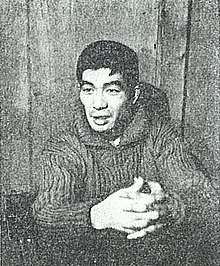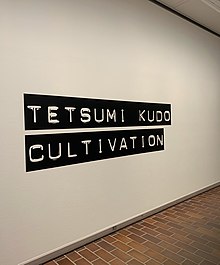Tetsumi Kudo
Tetsumi Kudo (23 February 1935 – 12 November 1990), was a Japanese artist associated with the Neo-Dada tradition.[1]
Tetsumi Kudo | |
|---|---|
 Tetsumi Kudo at the beginning of the 1960s | |
| Born | February 23, 1935 |
| Died | November 12, 1990 (aged 55) Tokyo, Japan |
| Nationality | Japanese |
| Education | Tokyo University of the Arts |
| Known for | Sculpture, Painter |
| Movement | Abstract expressionism |
Biography
Tetsumi Kudo was born in 1935 in Osaka, Japan and graduated from the Tokyo National University of Fine Arts in 1958. In 1957, he began exhibiting his work at the Salon of Independents, Yomiuri and had his first solo exhibition at the Galerie Blanche, Tokyo. He was awarded the Grand Prize and a travel grant to Paris through his participation in the 1962 Second International Young Artists Exhibition in Tokyo. His work made international appearances at the Venice Bienniale (1976), and the Biennial São Paulo (1977, awarded a special mention) while also appearing frequently in museums and galleries throughout Japan and France, with a growing recognition in the Netherlands. Notable museum solo exhibitions include the National Museum of Art, Osaka (1994), a joint-exhibition and catalogue organized by the Van Reekum Museum and the Stedelijk Museum in Amsterdam (1991), as well as the Hirosaki City Museum, Aomori (1986). In the year before his death, Galerie du Génie and FIAC dedicated a retrospective and catalogue to Kudo’s work. His work was most recently in a solo exhibition organized by La Maison Rouge and the Fondation Antoine de Galbert in Paris, accompanied by a catalogue written by Anne Tronche. His work can also be found in the collections of the Musée Moderne de la Ville de Paris, the Fonds National d’Art Contemporain, the Centre Georges Pompidou, and the National Museum of Art, Osaka. Kudo’s work made a rare appearance to US audiences in the Guggenheim’s 1994 exhibition, “Japanese Art After 1945: Scream Against the Sky,” and again in 1998 with its inclusion in a group exhibition at the MOCA LA “Out of Action: Between performance and the Object, 1949-1979.”
Tetsumi Kudo died of cancer on November 12, 1990 in Tokyo, Japan.[2]
Public collections

- Aomori Museum of Art, Aomori
- Centre Georges Pompidou, Paris
- Chiba City Art Museum, Chiba City
- Kurashi City Art Museum, Kurashi City
- Musée d’Art Contemperain de Marseilles, Marseilles
- Musée d’Art Moderne de la Ville de Paris, Paris
- Musée des Beaux Arts de Montréal
- Musée Moderne de la Ville de Paris, Paris
- Museum Moderner Kunst Stiftung Ludwig Vienna,
- Museum of Contemporary Art, Tokyo
- Museum of Modern Art, New York
- National Museum of Art, Osaka
- Stedelijk Museum voor Actuele Kunst, Ghent
- Stedelijk Museum, Amsterdam
- Walker Art Center, Minneapolis
References
- Smith, Roberta (4 July 2008). "Tetsumi Kudo". The New York Times. Retrieved 27 January 2016.
- Tetsumi Kudo: Garden of Metamorphosis Archived 2008-12-07 at the Wayback Machine, calendar.walkerart.org, retrieved 23 June 2009.